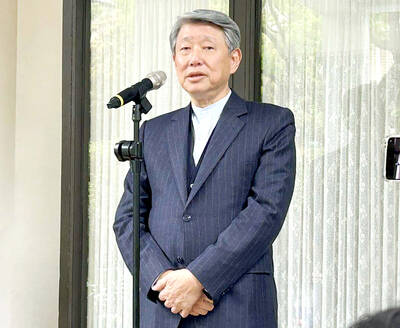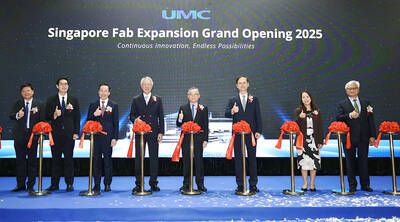A self-driving hybrid vehicle made by the Mobility Taiwan Automotive Research Consortium (mTARC, 台灣車輛移動研發聯盟) is to operate at Hsinchu’s Nanliao Harbor (南寮漁港) after being granted a license, the Industrial Technology Research Institute (ITRI, 工研院) said at an exhibition in Taipei yesterday.
Hsinchu Mayor Lin Chih-chien (林智堅) signed a memorandum of understanding with ITRI to allow the institute to test its self-driving vehicles in the city.
The institute said that it hopes the test could help improve the vehicles’ functions and safety systems.
“We want Hsinchu to be Taiwan’s first testing ground for self-driving cars, because we have a strong talent pool in the region,” Lin said.
Earlier this month, Lin said he hoped self-driving vehicles could be used to ease traffic jams in the city.
The main theme of mTARC’s exhibition this year is “intelligent mobility, connectivity and sharing.”
The consortium added “mobility” to its name this year, Ministry of Economic Affairs Department of Industrial Technology Director-General Lo Ta-sheng (羅達生) told a news conference yesterday.
Larry Chang (張念慈), director of ITRI’s Mechanical and Mechatronics Systems Research Labs, said that the autonomous vehicle is still being tested.
The institute has tested its self-driving vehicles in the Changhua Coastal Industrial Park (彰濱工業區) for three years, accumulating total mileage of more than 2,000km, he said.
Nanliao Harbor has sufficient roads and infrastructure for driving tests, Chang added.
The self-driving programs for a Luxgen Motor Co (納智捷) fossil-fuel car, designed by the Automotive Research & Testing Center (ARTC, 車輛研究測試中心), and a Chrysler hybrid car, designed by ITRI, are to be tested at Nanliao, Chang said.
ARTC is also developing electric shuttle buses, center researcher Tsai Hung-yih (蔡汯嶧) said.
mTARC develops autonomous driving for hybrid cars, fossil-fuel cars and electric buses to target different customers, he said.
“mTARC is a platform for various institutions to share technology and seek different possibilities,” Tsai added.
At the exhibition, the consortium displayed 23 research results in self-driving technology, such as sensors and thermographic cameras that locate and show pedestrians in all kinds of weather, image recognition systems that can distinguish objects on the road, intelligent LED headlights that can automatically avoid creating glare for oncoming drivers, sensors that can detect a driver’s status and an alarm system that warns a driver of obstacles in their blind spots.
Cameras and sensors installed in the self-driving vehicle collect and send data, which could be analyzed to show road status, traffic flow, parking lot status and pedestrian flow, Chang said.
Lin was presented a smartphone app that could start the engine of mTARC’s self-driving vehicle outside the exhibition hall.
The vehicle’s passenger safely exited the vehicle after sitting in the back seat for a few minutes.
The products displayed by mTARC are the result of research by the Chungshan Institute of Science and Technology, the Institute for Information Industry (資策會), ITRI, ARTC, the Metal Industries Research and Development Center (金屬工業研究發展中心), the Hua-Chuang Automobile Information Technical Center Co Ltd (華創車電技術中心) and 16 companies.

MULTIFACETED: A task force has analyzed possible scenarios and created responses to assist domestic industries in dealing with US tariffs, the economics minister said The Executive Yuan is tomorrow to announce countermeasures to US President Donald Trump’s planned reciprocal tariffs, although the details of the plan would not be made public until Monday next week, Minister of Economic Affairs J.W. Kuo (郭智輝) said yesterday. The Cabinet established an economic and trade task force in November last year to deal with US trade and tariff related issues, Kuo told reporters outside the legislature in Taipei. The task force has been analyzing and evaluating all kinds of scenarios to identify suitable responses and determine how best to assist domestic industries in managing the effects of Trump’s tariffs, he

TIGHT-LIPPED: UMC said it had no merger plans at the moment, after Nikkei Asia reported that the firm and GlobalFoundries were considering restarting merger talks United Microelectronics Corp (UMC, 聯電), the world’s No. 4 contract chipmaker, yesterday launched a new US$5 billion 12-inch chip factory in Singapore as part of its latest effort to diversify its manufacturing footprint amid growing geopolitical risks. The new factory, adjacent to UMC’s existing Singapore fab in the Pasir Res Wafer Fab Park, is scheduled to enter volume production next year, utilizing mature 22-nanometer and 28-nanometer process technologies, UMC said in a statement. The company plans to invest US$5 billion during the first phase of the new fab, which would have an installed capacity of 30,000 12-inch wafers per month, it said. The

Taiwan’s official purchasing managers’ index (PMI) last month rose 0.2 percentage points to 54.2, in a second consecutive month of expansion, thanks to front-loading demand intended to avoid potential US tariff hikes, the Chung-Hua Institution for Economic Research (CIER, 中華經濟研究院) said yesterday. While short-term demand appeared robust, uncertainties rose due to US President Donald Trump’s unpredictable trade policy, CIER president Lien Hsien-ming (連賢明) told a news conference in Taipei. Taiwan’s economy this year would be characterized by high-level fluctuations and the volatility would be wilder than most expect, Lien said Demand for electronics, particularly semiconductors, continues to benefit from US technology giants’ effort

‘SWASTICAR’: Tesla CEO Elon Musk’s close association with Donald Trump has prompted opponents to brand him a ‘Nazi’ and resulted in a dramatic drop in sales Demonstrators descended on Tesla Inc dealerships across the US, and in Europe and Canada on Saturday to protest company chief Elon Musk, who has amassed extraordinary power as a top adviser to US President Donald Trump. Waving signs with messages such as “Musk is stealing our money” and “Reclaim our country,” the protests largely took place peacefully following fiery episodes of vandalism on Tesla vehicles, dealerships and other facilities in recent weeks that US officials have denounced as terrorism. Hundreds rallied on Saturday outside the Tesla dealership in Manhattan. Some blasted Musk, the world’s richest man, while others demanded the shuttering of his